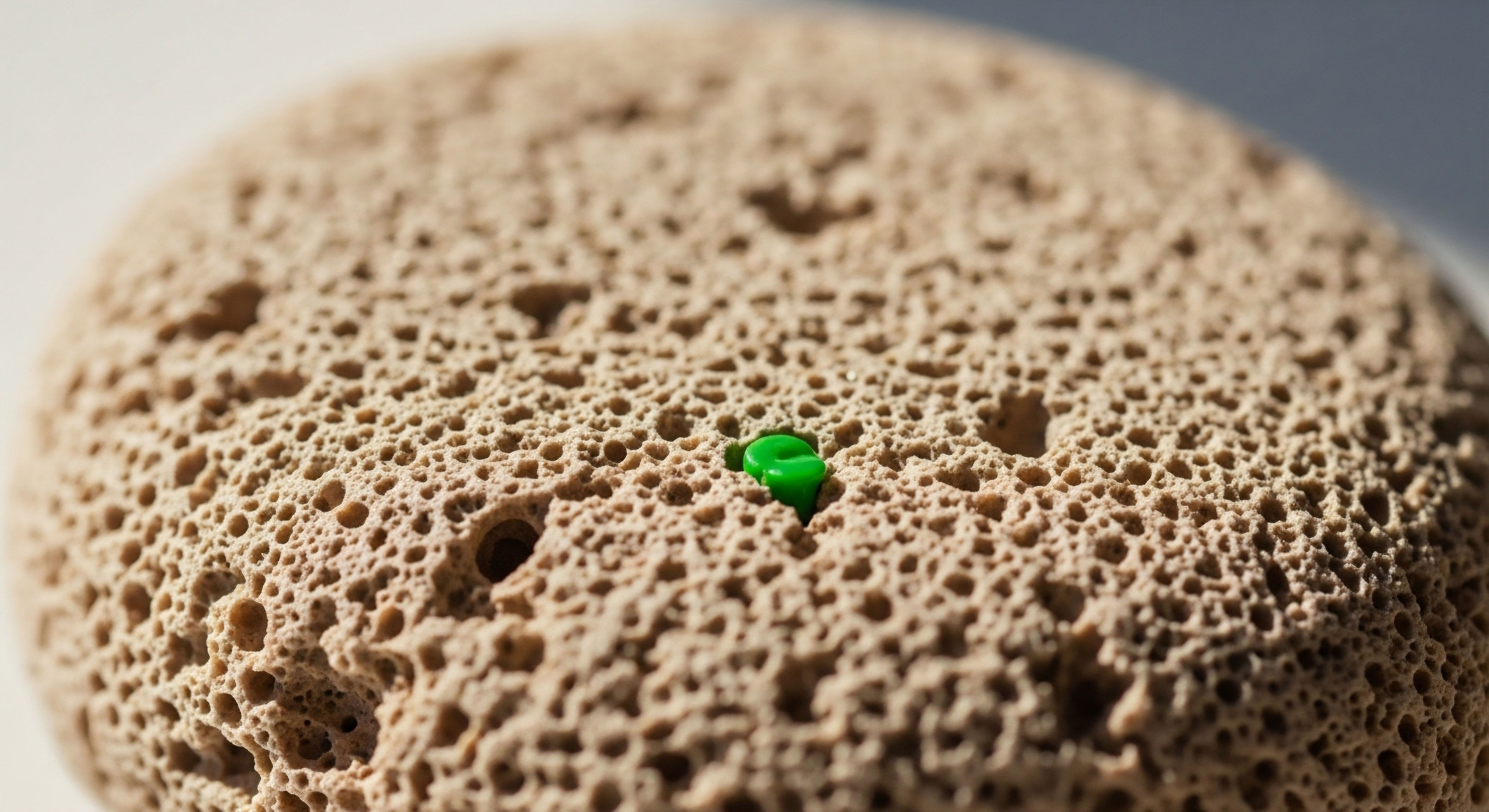

Fundamentals
Have you ever experienced a persistent dullness, a subtle shift in your energy, or a feeling that your body simply isn’t responding as it once did? Perhaps your sleep patterns have become erratic, or your physical recovery seems to lag.
These experiences, often dismissed as typical aging or daily stress, frequently signal a deeper conversation occurring within your biological systems. Your body communicates through an intricate network of chemical messengers, and when these signals falter, the impact on your vitality can be significant.
Within this complex internal communication system, tiny yet potent molecules known as peptides play a central role. Peptides are short chains of amino acids, acting as precise biological messengers that direct various cellular functions. They are the body’s own signaling agents, orchestrating processes from tissue repair and metabolic regulation to hormonal balance and cognitive function. When considering how these vital messengers are introduced into your system, the method of delivery becomes a critical determinant of their effectiveness and your comfort.
Peptides serve as the body’s inherent signaling molecules, guiding a multitude of biological processes.
The journey of a peptide from its administration point to its target cells involves navigating several biological landscapes. The chosen delivery route directly influences how much of the peptide reaches its intended destination, how quickly it arrives, and how long its beneficial effects persist. This concept, known as bioavailability, refers to the proportion of a substance that enters the circulation and can have an active effect. A higher bioavailability generally translates to a more potent and predictable therapeutic outcome.
Understanding the various ways peptides can be delivered provides a clearer picture of why certain protocols are chosen over others. Each method presents a unique set of considerations regarding absorption, stability, and the overall experience for the individual. The goal is always to maximize the therapeutic benefit while minimizing any inconvenience or discomfort, allowing you to regain a sense of balance and optimal function.

The Body’s Internal Messaging System
Your endocrine system, a collection of glands that produce and secrete hormones, operates like a sophisticated internal messaging service. Hormones, including many peptides, travel through the bloodstream to distant organs and tissues, where they bind to specific receptors and trigger particular responses. This system maintains homeostasis, ensuring all bodily functions operate within optimal ranges. When this delicate balance is disrupted, symptoms can manifest across multiple physiological domains.
Peptides, as a class of biomolecules, are distinct from larger proteins and smaller molecules. Their intermediate size grants them unique properties, allowing them to interact with specific cellular targets with high selectivity. This specificity often translates to fewer off-target effects compared to conventional pharmaceutical agents. Recognizing the inherent nature of these messengers is the first step toward appreciating the science behind their therapeutic application.


Intermediate
The selection of a peptide delivery method is a precise clinical decision, balancing the biochemical properties of the peptide with the desired therapeutic outcome and individual patient needs. Each route of administration presents distinct pharmacokinetic profiles, influencing how the peptide is absorbed, distributed, metabolized, and ultimately eliminated from the body. These profiles directly dictate the therapeutic efficacy and, significantly, patient adherence to the prescribed regimen.
Delivery method profoundly impacts peptide absorption, distribution, metabolism, and elimination, shaping therapeutic outcomes.

Parenteral Administration Methods
Parenteral routes, bypassing the digestive system, are frequently employed for peptide therapies due to the susceptibility of peptides to enzymatic degradation within the gastrointestinal tract. These methods ensure a more direct and predictable entry into the systemic circulation.

Subcutaneous Injections
Administering peptides via subcutaneous injection involves introducing the substance into the fatty tissue just beneath the skin. This method is a common choice for many peptide protocols, including certain growth hormone secretagogues like Sermorelin and Ipamorelin/CJC-1295, and also for female testosterone optimization protocols.
The subcutaneous route offers a relatively slow and steady absorption rate, leading to sustained peptide levels in the bloodstream. This gradual release can be advantageous for maintaining consistent therapeutic effects over time. Individuals often find subcutaneous injections less intimidating than intramuscular injections, promoting greater comfort and ease of self-administration at home. Common injection sites include the abdomen or thigh, allowing for rotation to prevent tissue irritation.

Intramuscular Injections
Intramuscular injections deliver peptides directly into muscle tissue, which is richly supplied with blood vessels. This route typically results in faster absorption and higher peak concentrations of the peptide compared to subcutaneous administration. For instance, Testosterone Cypionate, a cornerstone of male hormone optimization protocols, is commonly administered via intramuscular injection.
The rapid uptake can be beneficial when a swift onset of action is desired. While potentially more uncomfortable than subcutaneous injections for some, the less frequent dosing schedule often associated with intramuscular injections can enhance compliance for individuals requiring long-term therapy. Gluteal or deltoid muscles are typical sites for these injections.
The choice between subcutaneous and intramuscular injection often hinges on the specific peptide’s properties and the desired pharmacokinetic profile. Some peptides, due to their molecular weight or formulation, may exhibit different absorption characteristics depending on the injection site, with studies indicating variations in absorption rates across the abdomen, thigh, and upper arm.

Alternative Delivery Pathways
Beyond injections, other routes are explored to enhance patient convenience and expand therapeutic applications.

Oral Administration
The appeal of oral administration is undeniable due to its non-invasive nature and ease of use. However, delivering peptides orally presents substantial challenges. The harsh environment of the gastrointestinal tract, characterized by acidic pH levels and numerous proteolytic enzymes, can rapidly degrade peptides, significantly reducing their bioavailability.
This enzymatic breakdown means that only a small fraction of the orally administered peptide may reach the systemic circulation in an active form. Despite these hurdles, advancements in formulation science, including the use of absorption enhancers, enzyme inhibitors, and protective coatings, are making oral peptide delivery more feasible for select compounds, such as oral growth hormone secretagogues like MK-677.

Nasal Sprays
Nasal sprays offer a non-invasive route that bypasses hepatic first-pass metabolism, allowing for rapid absorption directly into the bloodstream through the highly vascularized nasal mucosa. This method is particularly useful for peptides requiring a quick onset of action, such as PT-141 for sexual health applications.
Challenges include mucociliary clearance, which can limit the residence time of the peptide in the nasal cavity, and the relatively low permeability of the nasal epithelium for larger molecules. Strategies to overcome these limitations involve the use of absorption enhancers and specialized delivery devices that improve deposition and retention in the upper nasal space.

Transdermal Applications
Transdermal delivery involves applying peptides to the skin, allowing them to permeate through its layers into the systemic circulation. This method offers the advantage of sustained release, avoiding gastrointestinal degradation and hepatic first-pass metabolism.
While the skin’s primary function as a barrier presents a challenge, technologies like microneedles, iontophoresis (using electric current), and sonophoresis (using ultrasound) are being developed to temporarily disrupt the skin barrier and enhance peptide absorption. This approach holds promise for long-term management protocols, reducing the frequency of administration and improving overall patient comfort.
Non-injectable peptide delivery methods, while convenient, face challenges in bioavailability and absorption that require advanced formulation strategies.

Comparing Delivery Methods
The choice of delivery method directly impacts the therapeutic journey. The table below provides a comparative overview of common peptide delivery methods, highlighting their characteristics and implications for patient experience.
| Delivery Method | Absorption Rate | Bioavailability | Patient Compliance | Typical Peptide Examples |
|---|---|---|---|---|
| Subcutaneous Injection | Slow to Moderate | High | Good (self-administration) | Sermorelin, Ipamorelin/CJC-1299, Female Testosterone Cypionate |
| Intramuscular Injection | Moderate to Fast | Very High | Moderate (less frequent) | Testosterone Cypionate (Male TRT) |
| Oral Administration | Variable | Low (improving with tech) | Very High | MK-677, Oral Semaglutide |
| Nasal Spray | Fast | Moderate to Low | High | PT-141 |
| Transdermal | Slow, Sustained | Variable (tech-dependent) | Good (non-invasive) | Testosterone Gels (less common for peptides) |

Optimizing Protocols for Patient Well-Being
For conditions requiring consistent hormonal support, such as Testosterone Replacement Therapy (TRT), the delivery method is chosen to maintain stable physiological levels. For men, weekly intramuscular injections of Testosterone Cypionate (200mg/ml) are a standard protocol, often combined with subcutaneous Gonadorelin to support natural testosterone production and fertility, and oral Anastrozole to manage estrogen conversion. This combination aims to optimize the endocrine environment while mitigating potential side effects.
Women undergoing hormonal balance protocols, particularly those in peri- or post-menopause, might receive Testosterone Cypionate via subcutaneous injection (typically 10 ∞ 20 units weekly). Progesterone may be prescribed based on menopausal status, and long-acting testosterone pellets, with Anastrozole if appropriate, offer another option for sustained delivery. These tailored approaches recognize the unique physiological needs of each individual, striving for symptom resolution and enhanced well-being.
The administration of Gonadorelin, for instance, can be precisely controlled to mimic the body’s natural pulsatile release of gonadotropin-releasing hormone (GnRH). This pulsatile delivery is essential for stimulating the pituitary gland to release luteinizing hormone (LH) and follicle-stimulating hormone (FSH), which in turn support endogenous testosterone production and spermatogenesis in men, or ovulation in women. Conversely, continuous administration of Gonadorelin can suppress LH and FSH secretion, a mechanism utilized in different therapeutic contexts.
Personalized wellness protocols carefully select delivery methods to align with the peptide’s action and the individual’s physiological needs.

Administering Subcutaneous Injections
Proper technique for self-administering subcutaneous injections is vital for both efficacy and safety. A typical procedure involves several steps ∞
- Preparation ∞ Gather all necessary supplies, including the peptide vial, sterile syringe, alcohol wipes, and a sharps container.
- Hygiene ∞ Wash hands thoroughly with soap and water.
- Site Selection ∞ Choose an injection site with adequate subcutaneous tissue, such as the abdomen (at least an inch from the navel) or the upper thigh. Rotate sites with each injection.
- Vial Preparation ∞ Clean the rubber stopper of the peptide vial with an alcohol wipe. Draw the prescribed dose into the syringe, ensuring no air bubbles remain.
- Skin Preparation ∞ Clean the chosen injection site with an alcohol wipe and allow it to air dry completely.
- Injection ∞ Pinch a fold of skin at the prepared site. Insert the needle at a 45- to 90-degree angle, depending on the needle length and skin fold thickness. Slowly depress the plunger to inject the peptide.
- Withdrawal ∞ Remove the needle smoothly and apply gentle pressure to the injection site with a clean cotton ball or gauze. Do not rub the area.
- Disposal ∞ Immediately dispose of the used syringe in a designated sharps container.
Adhering to these steps minimizes discomfort and reduces the risk of local reactions or infection, ensuring the peptide is delivered effectively.


Academic
The profound influence of peptide delivery methods extends to the very core of cellular and systemic physiology, dictating not only the quantity of active compound reaching its target but also the precise temporal dynamics of its interaction. This deep consideration moves beyond simple absorption rates to encompass the intricate interplay of pharmacokinetics, receptor kinetics, and the body’s inherent feedback mechanisms. A systems-biology perspective reveals how a chosen delivery route can subtly, yet significantly, recalibrate endocrine axes and metabolic pathways.

Pharmacokinetic Determinants of Efficacy
The journey of a peptide from administration to cellular action is governed by its pharmacokinetics, which describes how the body handles the substance. This includes its absorption into the bloodstream, distribution to various tissues, metabolism (breakdown), and excretion. For peptides, particularly those administered parenterally, the rate and extent of absorption from the injection site are critical.
Subcutaneous and intramuscular routes bypass the gastrointestinal tract’s enzymatic gauntlet, yet they still encounter local proteases and peptidases in the interstitial space and lymphatic system, which can reduce bioavailability compared to direct intravenous delivery.
The molecular weight of a peptide influences its absorption pathway from subcutaneous or intramuscular sites. Smaller peptides, typically below 1 kDa, primarily diffuse into blood capillaries. Larger peptides, ranging from 1 to 10 kDa, are absorbed through both lymphatic vessels and blood capillaries, though capillary diffusion remains the primary mechanism for most therapeutic peptides. This differential absorption impacts the onset and duration of action, influencing how quickly a therapeutic effect is observed and how frequently dosing is required.

Enzymatic Degradation and Stability
Peptides are inherently susceptible to enzymatic degradation by proteases, both in the bloodstream and within tissues. This susceptibility contributes to their often-short biological half-lives, necessitating frequent administration to maintain therapeutic concentrations. Strategies to enhance peptide stability include structural modifications, such as incorporating non-natural amino acids, cyclization, or PEGylation (covalent attachment of polyethylene glycol). These modifications can create steric hindrance, protecting the peptide from enzymatic cleavage and prolonging its circulation time.
Nanotechnology offers another avenue for protecting peptides from degradation. Encapsulating peptides within nanoparticles or coating them with biocompatible materials provides a protective shield, preserving their structure and bioactivity during storage and delivery. These advanced delivery systems can also facilitate targeted delivery to specific cells or tissues, enhancing the specificity of peptide action and potentially reducing systemic side effects.

How Does Delivery Influence Endocrine Feedback Loops?
The endocrine system operates through intricate feedback loops, where the secretion of one hormone influences the production or release of another. The manner in which exogenous peptides are delivered can significantly impact these delicate regulatory mechanisms.

Pulsatile versus Continuous Signaling
Many endogenous hormones, including gonadotropin-releasing hormone (GnRH), are released in a pulsatile fashion, meaning in bursts rather than a continuous stream. This pulsatile pattern is critical for maintaining the sensitivity of target receptors and eliciting appropriate physiological responses. For instance, the pulsatile administration of Gonadorelin, a synthetic GnRH, is essential for stimulating the pituitary gland to release LH and FSH, thereby supporting gonadal function and fertility.
Conversely, continuous administration of GnRH or its analogs can lead to receptor desensitization and downregulation, effectively suppressing hormone production. This mechanism is therapeutically exploited in conditions where suppression of gonadal hormones is desired, such as in certain hormone-sensitive cancers or endometriosis. The delivery method, therefore, directly influences whether a peptide acts as a stimulator or a suppressor of an endocrine axis, highlighting the precision required in therapeutic design.
The precise timing and pattern of peptide delivery can either stimulate or suppress endocrine pathways, underscoring the importance of administration method.

Impact on Hypothalamic-Pituitary-Gonadal Axis
Consider the Hypothalamic-Pituitary-Gonadal (HPG) axis, a central regulatory pathway for reproductive and hormonal health. The hypothalamus releases GnRH in pulses, which stimulates the pituitary to release LH and FSH. These gonadotropins then act on the gonads (testes in men, ovaries in women) to produce sex hormones like testosterone and estrogen.
When administering exogenous hormones or peptides that interact with this axis, the delivery method’s influence on the pharmacokinetic profile becomes paramount. For example, the sustained release of testosterone from intramuscular injections or pellets aims to mimic the relatively stable circulating levels of endogenous testosterone, supporting secondary sex characteristics and overall well-being.
However, maintaining the delicate balance requires careful monitoring of related hormones, such as estradiol, which can be influenced by testosterone conversion. Oral Anastrozole is often co-administered to manage this conversion, demonstrating the interconnectedness of these protocols.

Advanced Delivery Systems and Future Directions
The field of peptide delivery is continuously evolving, with ongoing research into novel systems that can overcome existing barriers and enhance therapeutic outcomes.

Targeted Delivery and Controlled Release
Advanced delivery systems aim for more precise and controlled release of peptides. Targeted delivery involves engineering carriers, such as nanoparticles, to selectively accumulate at specific cells or tissues, minimizing off-target effects and maximizing therapeutic concentration where it is needed most. This approach is particularly relevant for peptides used in localized tissue repair or specific anti-inflammatory actions, such as Pentadeca Arginate (PDA).
Controlled release systems are designed to deliver peptides over extended periods, reducing dosing frequency and improving patient compliance. These systems can be engineered to respond to specific physiological stimuli, such as pH changes or enzymatic activity, triggering the release of the encapsulated peptide only when and where it is required. This level of control represents a significant advancement in optimizing peptide therapy.
| Advanced Delivery Strategy | Mechanism | Potential Benefits |
|---|---|---|
| Nanoparticle Encapsulation | Protects peptides from degradation; enables targeted delivery. | Enhanced stability, improved bioavailability, reduced off-target effects. |
| Microneedle Patches | Creates transient pores in skin for peptide permeation. | Non-invasive alternative to injections, sustained release, improved patient comfort. |
| Pulsatile Pumps | Delivers peptides in timed, intermittent bursts. | Mimics natural hormone secretion, optimizes receptor sensitivity. |
| Prodrug Strategies | Peptide modified to improve absorption, then converted to active form in body. | Improved oral bioavailability, enhanced stability. |

What Role Does Patient Compliance Play in Therapeutic Success?
Beyond the scientific intricacies, the human element of patient compliance remains a cornerstone of therapeutic success. Even the most scientifically sound protocol will yield suboptimal results if the individual struggles to adhere to the prescribed regimen. Delivery methods that are less invasive, require less frequent administration, or are easier to self-administer generally lead to higher compliance rates.
The balance between achieving optimal pharmacokinetic profiles and ensuring patient comfort and convenience is a continuous consideration in clinical practice. For instance, while intramuscular injections might offer superior bioavailability for certain compounds, the discomfort associated with them might lead some individuals to miss doses.
Subcutaneous options, though sometimes requiring more frequent administration, can be more readily adopted into daily routines. Ultimately, a personalized approach that considers both the biological imperatives and the individual’s lifestyle and preferences is essential for maximizing the benefits of peptide therapies.

References
- Brayden, David J. “An Update on Oral Administration of Peptides to Achieve Systemic Delivery.” Pharmaceutical Research, vol. 40, no. 3, 2023, pp. 581-602.
- Diamond, L. E. et al. “Co-administration of low doses of intranasal PT-141, a melanocortin receptor agonist, and sildenafil to men with erectile dysfunction results in an enhanced erectile response.” International Journal of Impotence Research, vol. 17, no. 5, 2005, pp. 463-467.
- Fortuna, A. et al. “Nasal Delivery of High Molecular Weight Drugs.” Pharmaceutics, vol. 6, no. 3, 2014, pp. 473-492.
- Grewal, R. et al. “Pharmacokinetics, safety, and patient acceptability of subcutaneous versus intramuscular testosterone injection for gender-affirming therapy ∞ A pilot study.” American Journal of Health-System Pharmacy, vol. 75, no. 6, 2018, pp. 381-388.
- Khafagy, E. S. et al. “Systemic and brain delivery of antidiabetic peptides through nasal administration using cell-penetrating peptides.” Frontiers in Pharmacology, vol. 13, 2022, p. 1046968.
- Mittal, A. et al. “A Current Review on Transdermal Delivery of Protein and Peptides ∞ Possibilities and Challenges.” Current Pharmaceutical Design, vol. 31, no. 1, 2025, pp. 10-25.
- Prausnitz, M. R. & Langer, R. “Transdermal drug delivery.” Nature Biotechnology, vol. 26, no. 11, 2008, pp. 1261-1268.
- Rao, M. et al. “Challenges and Opportunities in Delivering Oral Peptides and Proteins.” Expert Opinion on Drug Delivery, vol. 18, no. 1, 2021, pp. 1-14.
- Sigalos, J. T. & Pastuszak, A. W. “The Safety and Efficacy of Growth Hormone Secretagogues.” Sexual Medicine Reviews, vol. 6, no. 1, 2018, pp. 45-53.
- Van den Berghe, G. et al. “Five-Day Pulsatile Gonadotropin-Releasing Hormone Administration Unveils Combined Hypothalamic-Pituitary-Gonadal Defects Underlying Profound Hypoandrogenism in Men with Prolonged Critical Illness.” The Journal of Clinical Endocrinology & Metabolism, vol. 87, no. 10, 2002, pp. 4710-4718.

Reflection
Your health journey is uniquely yours, marked by individual symptoms, concerns, and aspirations for vitality. The scientific insights shared here regarding peptide delivery methods are not merely academic concepts; they are tools for self-discovery. They offer a framework for understanding how precise interventions can influence your biological systems, guiding you toward a state of optimal function.

Reclaiming Your Biological Potential
Consider this knowledge as a starting point, an invitation to engage more deeply with your own physiology. The path to reclaiming vitality often involves a collaborative effort with clinical professionals who can interpret your unique biological signals and tailor protocols to your specific needs. This partnership empowers you to make informed decisions about your well-being, moving beyond generic solutions to truly personalized care.
The science of hormonal health and metabolic function is continuously advancing, offering increasingly sophisticated ways to support your body’s innate intelligence. By appreciating the intricacies of peptide delivery and its impact on therapeutic efficacy, you are better equipped to advocate for your health and pursue strategies that align with your personal goals for longevity and robust function. Your body possesses an incredible capacity for recalibration; understanding its language is the key to unlocking that potential.



